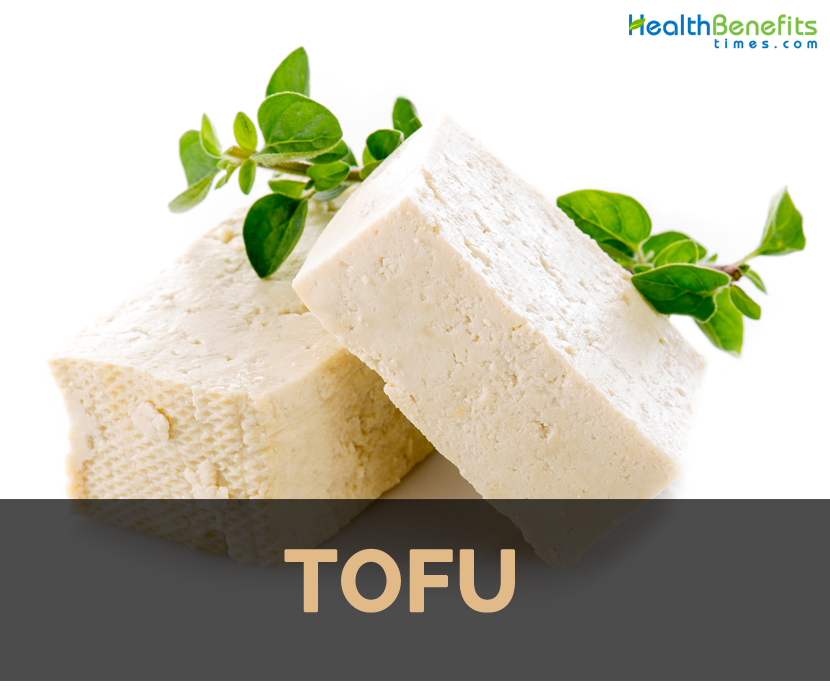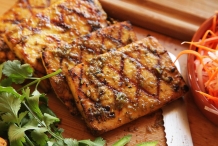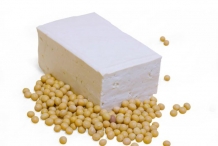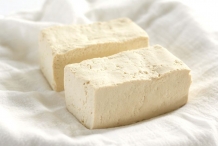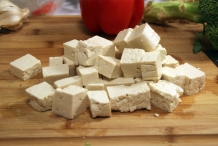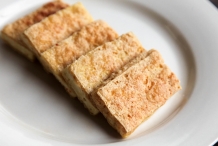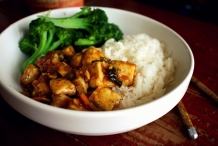Tofu contains low content of fat with high amount of protein which is essential for proper functions of the body. Due to the low content of calories it makes a healthy option for those who are trying to lose weight. Moreover, it has low amount of sodium and no cholesterol which makes tofu beneficial for heart health. It contains trace amounts of potassium and zinc. Its organic compounds comprises of isoflavones which provide vital impact on human health. It contains meaningful amount of thiamin, Vitamin K, Vitamin B6, riboflavin and folate. It also has small amounts of niacin and pantothenic acid. It assists in preventing chronic diseases such as high blood pressure, diabetes and also prevents the chances of prostate and breast cancer. Additionally, tofu assists weight loss and prevents the chances of early aging.
History
The preparation of tofu was firstly recorded some 2000 years ago during Chinese Han dynasty. The Chinese legend attributes its invention to Prince Liu An. The production technique of Tofu was introduced to Korea and during Nara period to Japan. It is also believed that Tofu arrived during 10th and 11th centuries in Vietnam. It was then spread to other parts of Southeast Asia which is coincided with the spread of Buddhism as it is a vital protein source in vegetarian diet of East Asian Buddhism. In Ming Dynasty, Li Shizhen described the method for making tofu in Compendium of Materia Medica. The increase in acceptance of tofu is probably coincided with Buddhism as it is a great source of protein in vegetarian diet of that religion. Then tofu became a predominant part of diet in various countries such as Korea, Thailand and Vietnam with exquisite variations in production methods, flavor, texture and usage.
Health Benefits of Tofu
Tofu has isoflavones as a main component which could lower the chances of osteoporosis in women and counteract cholesterol. Tofu also enhances hair growth. It also tones muscles and preserves elasticity of skin. It is effective in slowing aging process. The daily consumption of tofu prevents damage of blood vessels. Soy foods help to reduce triglycerides and cholesterol levels in blood and stabilize blood pressure levels. It is a great source of iron which is essential for healthy blood. Iron with hemoglobin is essential for producing energy to transport as well as release oxygen in the body.
- Prevent cardiovascular problems
Isoflavines found in soy helps to lower bad cholesterol levels. A study shows that regular intake of soy lowers cardiovascular diseases such as body mass index, weight and total cholesterol. The consumption of tofu is an alternative to animal protein that assists in lowering LDL cholesterol levels. It also results in lowering the chances of high blood pressure and atherosclerosis.
- Cancer prevention
Soy has genistein which is a most important isoflavone that contains antioxidant properties which inhibits growth of cancer cells. The consumption of moderate amounts of soy foods donot affects growth of tumor or chances of developing breast cancer. The evidence has shown that daily intake of soy lowers recurrence of breast cancer. Researchers need more studies for confirming how genistein works, how it could be used therapeutically and its bioavailability.
- Kidney health
Protein promotes renal function and its benefits for patients who undergo dialysis or kidney transplantation. The meta analysis of nine trials shows positive effect of Soy on some biomarkers of those having chronic kidney problems. It might be due to protein content and its impact on blood lipid levels.
- Relieve menopause symptoms
Research shows that soy products consumption provides relief from menopause symptoms such as hot flashes due to the presence of phytoestrogens. The symptoms vary between women. The people of Asian countries consume more soy and hot flashes in women appear to be far less. The evidence shows that consumption of soy products which have high content of genistein lowers the severity and frequency of hot flashes. Tofu has calcium as well as vitamin B which calms down nerves and stable mentality for resolving irritability.
- Brain health
Studies have shown that people with high intake of soy lowers the chances of age associated mental problems. The treatment with soy isoflavones is associated with better performance in nonverbal memory and verbal fluency. The study conducted on 65 people over age of 60 years with Alzheimer’s , it did not found isoflavins soy offered any cognitive benefits. The study showed that soy products have lecithin content which assist people with Alzheimer’s disease by producing phospholipids phosphatidic acid and phosphatidylserine.
- High protein
Human body requires protein for proper functioning. Vegetarian could get adequate amount of protein due to consumption of tofu, vegetables and other soy products. It has amino acids which is essential for optimal health. The intake of red meat frequently could result in health implications. It could be avoided by replacing it with tofu.
- Strong bones
Tofu is a great source of calcium which is a vital ingredient in formation of bones. The deficiency of calcium could result in osteoporosis, poor formation of new bones and rapid aging due to brittle bones. Though everyone is procumbent to aging at some point which could be avoided by consuming tofu that slows down entire process by maintaining strong bones.
- Promote blood circulation
Iron has vital role in transporting oxygen to various body parts and body relies heavily on oxygen. It is the function of hemoglobin for transporting oxygen to every body part that is essential for generation of energy. Hemoglobin endure in blood and forms through the use of iron which is present in body. It assists to promote circulation of blood in the body due to the presence of copper and iron content. It prevents symptoms of anemia and keeps organ running smoothly due to proper oxygenation.
- Beauty purpose
Protein helps to form skin cells which are replenished in a four week cycle. It continuously replaces old cells with new cells. So people should replenish protein constantly. Animal protein has fats which include saturated fatty acids which when absorbed into system leads to secretion of excess fats through skin that causes pores to wide open. The smooth complexion could be maintained by consuming vegetable protein food such as tofu. Moreover, constipation also causes skin problems which are essential for ingesting fiber for invigorate intestinal activity.
- Prevention of anemia
Tofu also lowers the risk of getting anemia. The study which was conducted in China shows the association between anemia and intake of tofu which lowers the chances of anemia in adults.
Types of tofu
Varieties of tofu could be found in both Eastern and Western markets. Tofu products are divided into two categories: fresh tofu which is prepared directly from soy milk and processed tofu is made from fresh tofu.
- Fresh tofu
Fresh tofu could be divided into four varieties such as soft, extra soft, extra firm and firm which depend on the amount of water extracted from tofu curds. Fresh tofu is sold immersed in water in order to maintain its moisture content.
a. Extra soft
In Korean, extra soft tofu is known as sun-dubu. Sea water or saline water made with sea salt is mixed with soy milk to curdle. The curd remains loose and soft. It is consumed boiled with no or little seasoning. Usually it is sold in tubes. It is used as a vital ingredient in sundubu-jjigae.
b. Soft
Also known as silken tofu, Soft tofu is undrained and unpressed tofu which contains high content of moisture. It is prepared by coagulating soy milk without curdling it. It is found in various consistencies such as firm and soft. In Korea and Japan, it is made with sea water. Soft tofu is versatile and reliable substitute for dairy products and eggs.
c. Firm
Firm tofu is drained and pressed. It contains high content of moisture with firmness of raw meat and bounce back readily when pressed. The skin of this Firm tofu has pattern of muslin which is used to drain it. It could be easily picked up with chopsticks.
d. Extra firm
In this extra firm tofu, large amount of liquid has been pressed out. It has low content of moisture with firmness of fully cooked meat and has rubbery feel identical to paneer. This tofu can easily be crumbled when sliced thinly. The skin has pattern of muslin which has been used to drain and press it.
- Processed tofu
Various forms of processed tofu are available which is due to various ways in which fresh tofu is used.
a. Fermented
Pickled tofu is also known as preserved tofu or fermented tofu. It possesses cubes of dried tofu which are fully air-dry under hay and then slowly fermented with the use of aerial bacteria. Dry fermented tofu is soaked in salt water, vinegar, Chinese wine and minced chiles.
Stinky tofu is a soft tofu which is fermented in a unique vegetable and fish brine. It has the smell of strongly pungent cheeses or rotten food. The texture is similar to soft Asian tofu from which it is prepared.
b. Frozen
Thousand-layer tofu: When tofu is frozen, the large ice crystals which develop within it leads in formation of large cavities which appear as layered. It has yellowish hue in freezing process. It goes well with tatsoi as a winter dish.
Koya tofu also called shimidofu is made with the use of nigari.
Kori tofu is a frozen tofu which is freeze-dried.
Koya-dofu: In Japanese markets, it is sold in freeze-dried blocks or cubes. It could be preserved for long term since it could be dried. Before consumption, it must be soaked in water. It has mildly sweet or savory flavor and spongy texture when prepared in a usual manner.
Tofu miso hummus
Ingredients:
- 1 garlic clove (crushed)
- 4 tbsp Tahini
- 150 g Silken tofu
- Juice from ½ Lemon
- 1 tbsp Soy sauce
- 4 tbsp of Peanut or olive oil
- Salt and black pepper
- ½ tbsp white miso
- 2 tbsp chopped chives
Directions:
- In a small bowl, firmly whisk garlic, tofu and tahini in a small bowl. Then stir all the remaining ingredients and again whisk it.
- Sprinkle with chopped chives, then serve.
Traditional uses
Tofu has protein in it which promotes skin elasticity and tones facial muscles.
Precautions
- It causes the allergic symptoms such as rash or difficulty in breathing.
- Tofu might cause food poisoning such as gas, nausea, bloating, abdominal cramps, diarrhea, vomiting, headache or fever.
- High intake of tofu might be harmful because proteins will turn into waste and increases burden on kidneys and causes indigestion.
- Tofu has high content of methionine which increases the chances of atherosclerosis.
- Consume it in moderate amounts to avoid health problems.
- People who are allergic to soy might be allergic to tofu as well.
- People having kidney and gallbladder stones should avoid it.
- Tofu has protein in it which promotes skin elasticity and tones facial muscles.
- It might cause health problems such as thyroid problems, lethargy, weight gain, fatigue, malaise, hair loss and loss of libido.
How to Eat
- In Chinese cuisine, tofu is served with adzuki beans, boiled peanuts, tapioca and cooked oatmeal.
- It is used as a condiment with congee or rice.
- Extra firm and firm tofu is also stir fried and grilled.
- Silken tofu is used for dips and puddings.
- Flavor tofu with onion or ginger and season with spices.
- Tofu is served in soups, sauces, smoothies and stir fry.
- It is eaten raw or stuffed with filings.
- In Southeast Asia, tofu is served as a part of main course and dessert.
- Fresh tofu, sago and brown sugar syrup is used in Philippines to make Taho which is a sweet delicacy.
References:
https://en.wikipedia.org/wiki/Tofu
https://www.medicalnewstoday.com/articles/278340.php
https://www.britannica.com/topic/tofu
http://www.happydieter.net/everything-you-should-know-about-tofu/
https://www.tarladalal.com/glossary-tofu-1049i
http://smilepls.com/answers/interesting-facts-about-tofu.html
https://www.medicalnewstoday.com/articles/278340.php
https://www.curejoy.com/content/tofu-beauty-health-benefits-side-effects/
https://www.organicfacts.net/tofu.html
Comments
comments
| Tofu Quick Facts | |
|---|---|
| Name: | Tofu |
| Calories | 77 Kcal./cup |
| Major nutrients | Manganese, Mn 0.424 mg (18.43%) Tryptophan 0.076 g (17.27%) Iron, Fe 1.38 mg (17.25%) Total Fat (lipid) 5.72 g (16.34%) Selenium, Se 8.1 µg (14.73%) |
| Health benefits | Prevent cardiovascular problems, Cancer prevention, Kidney health, Relieve menopause symptoms, Brain health |
